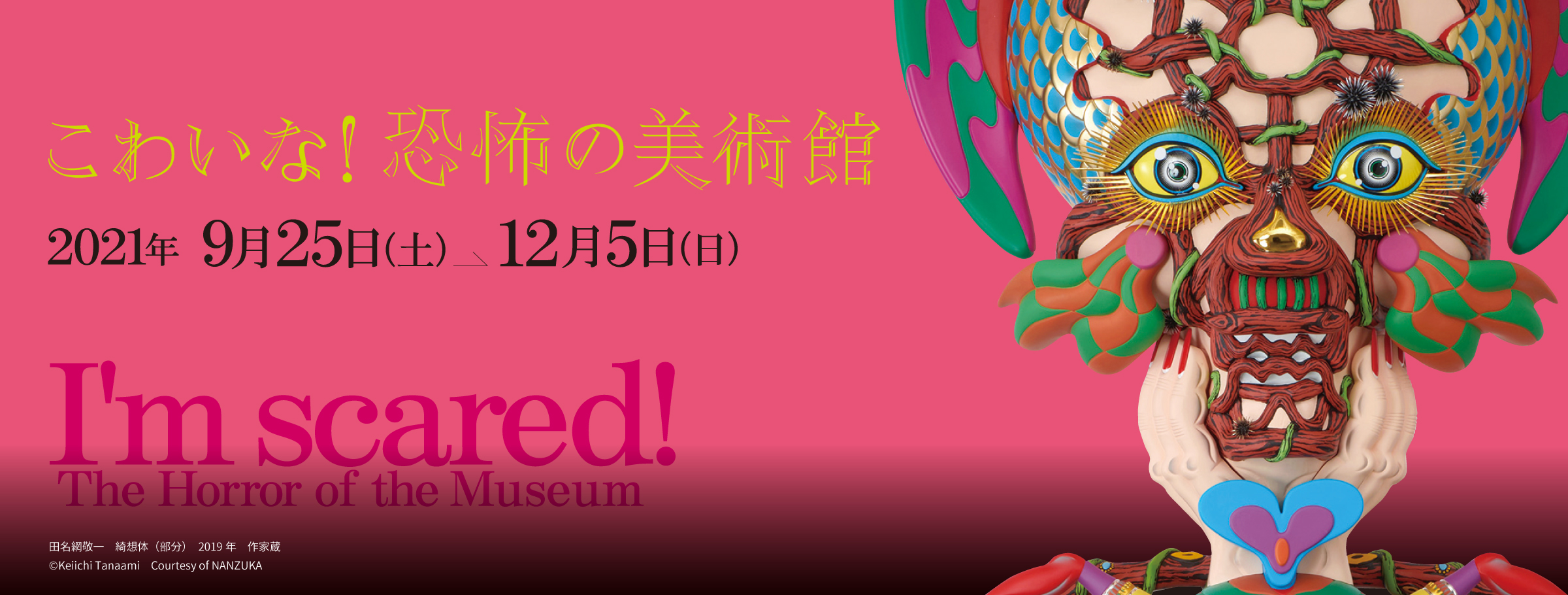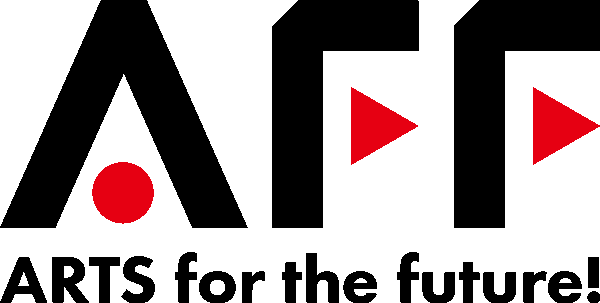
I’m scared! The Horror of the Museum
Five years after the Kumamoto Earthquake and in the midst of the COVID-19 pandemic, this exhibition will introduce works around the theme of “It” (that which inspires fear and anxiety). This collection of artwork showcases the excellent creativity of four artists, one author and one theatrical company who brilliantly capture the fear and anxiety of our subconscious mind.
The Kumamoto Earthquake forced us citizens to suffer through unprecedented horrors, as well as the anxiety caused by aftershocks that continued unabated long after the disaster. Furthermore, a series of natural disasters throughout the country and the COVID-19 pandemic have made our fears and anxieties diverse and ever present. The stress of spending everyday life with “It,” our fear and anxiety, is exhausting. And yet, there are artists who demonstrate the power of creativity by encapsulating “It” as a natural human emotion.
The variety of artistic expressions contains humor and many unique interpretations that encourage (and sometimes stimulate) a change in your thinking, and we hope it will be an opportunity to generate energy and ideas to protect yourself and your loved ones from “It.”
Artists
Odilon Redon, Chimei Hamada, Keiichi Tanaami, Yoko Koda, Shinji Ishii and Namuthunder
How to Enjoy the Exhibition to the Fullest
Unravel “It” (fear and anxiety) with Three Keywords
The artwork in this exhibition will be grouped together by artist so visitors can enjoy each artist’s world one by one. At the same, we will use this site to introduce three keywords that all the pieces have in common so you can get the most out of the exhibition.
*Even people who don’t like scary things can fully enjoy this exhibition (it is about scary things but we promise there is nothing to fear).
1.Terrifying Places… Haunted Houses and the Horror of No Escape
Namuthunder, Odilon Redon and Chimei Hamada
Western and Japanese haunted houses are actually completely different. Although they are called houses in Japan, the interior of Japanese haunted houses provide space for a pseudo-outdoor experience where you will encounter a strange world of ghosts within our own. In Western haunted houses, the house contains the evil and is therefore a type of monster in and of itself. In the rooms, you will encounter the ghosts of past events that took place in the house.
In addition, modern haunted houses are built like mazes to keep you from knowing where the exit is.Fear and anxiety continue to build as you lose sight of how long it will last and when something will happen (just like our daily mindset during the COVID-19 pandemic).
When you finally reach the exit and escape the state of terror at the peak of your fear and anxiety, your mind clears and is filled with joy and peace of mind. The haunted house experience also includes comforting others by smiling and saying things like, “That was terrifying!” afterwards.
*There is a Japanese style haunted house run by Namuthunder at the entrance of the exhibition. Those who don’t like scary things can avoid it by using the route labeled“Not Scary.”
-

Namuthumder Namuthunder’s Theatrical Haunted House @ Daigaku-yu 2020 (ref.) -

Chimei Hamada Dead End 1981 Kumamoto prefectural Museum of Art
©Hiroko Hamada 2021/JAA2100062 -

Odilon Redon The Haunted House I. Above I saw the hazy contours of human form (La maison hantée I. Je vis dessus le contour vaporeux d'une forme humaine) 1896 The Museum of Fine Arts, Gifu -

Odilon Redon The Haunted House II. I saw a glimmer of light, broad and pale (La maison hantée II. Je vis une lueur large et pâle) 1896 The Museum of Fine Arts, Gifu
2.Scary Hours… Midnight
Keiichi Tanaami, Yoko Koda and Odilon Redon
Inside Japanese haunted houses, time has frozen at 2 o’clock in the middle of the night, and it is incredibly dark, much like in Western versions. In many horror movies, the horror begins in the evening and continues onward into the night.
Darkness has been scary since the beginning of time. There could be something strange lurking in the dark that may hurt you. Most horror movies end when the heroes find a solution just as dawn breaks, but as aftershocks continued to occur for days after the Kumamoto Earthquake, there are many people who had to wait for the same relief each dawn.
On the other hand, there is also a peculiar fun unique to nighttime. The brilliant illumination of urban life has a beauty completely different from daytime, and, of course, there are rich and romantic times spent admiring the stars, the moon, and the cherry blossoms at night.
Keiichi Tanaami Red Shade 2021 collection of the artist
©Keiichi Tanaami Courtesy of NANZUKA
-

Odilon Redon The Haunted House V. Such hideous larvae ( La maison hantée V. Des larves si hideuses ) 1896 The Museum of Fine Arts, Gifu -

Odilon Redon Haunting (Hantise) 1894 The Museum of Fine Arts, Gifu
-

Yoko Koda YORU NO KIOKU (Memories of the Nights) 01 The Bird Carrying Tomorrow 2016 private collection
©Yoko Koda -

Yoko Koda YORU NO KIOKU (Memories of the Nights) 02 The Cat Named “YORU(Night)” 2016 Treatment Salon Mimosa
©Yoko Koda -

Yoko Koda YORU NO KIOKU (Memories of the Nights) 09 The Night Story 2016 private collection
©Yoko Koda
3.The Form of Fear… Anxiety about Unknown Creatures, Our Fascination with Ghosts
Odilon Redon, Chimei Hamada, Keiichi Tanaami and Shinji Ishii
There are many Japanese ghost stories, such as “Hyakumonogatari (100 Strange Tales),” that date back to the Edo period, and horror manga and novels are still popular to this day. The city dwellers’ fascination with and search for ghosts produced creatures such as Kuchisake-onna (Woman with a torn mouth), human-faced dogs, and human-faced fish in the Showa and Heisei eras, and last year Amabie became incredibly popular as an epidemic prevention symbol.
Since the Edo period, urban ghosts have appeared at the edge of daily life where boundaries blend vaguely, such as a dark road at midnight and places people would not usually go.
Giving a shape to an object of fear (something that cannot be understood) and determining a place where it appears is a basic way to accept, understand, and cope with the existence of unknown beings (just like disaster prevention and COVID-19 countermeasures).
-

Odilon Redon Spider (Araignée) 1887 The Museum of Fine Arts, Gifu -

Chimei Hamada Person with Excessive Information 1984 Kumamoto prefectural Museum of Art
©Hiroko Hamada 2021/JAA2100062 -

Chimei Hamada Somewhat Neurotic 1975 Kumamoto prefectural Museum of Art
©Hiroko Hamada 2021/JAA2100062 -

Keiichi Tanaami Inconceivable Body 2019 collection of the artist
©Keiichi Tanaami Courtesy of NANZUKA -

Shinji Ishii Note for new novel “Hyakumonogatari (100 Strange Tales)” 2021 *First public release at the venue.
How was it? Did the three keywords help you break down and understand your fear and anxieties?
Be very careful and enjoy the Horror of the Museum!
Exhibition Information
-
Dates
-
September 25(Sat.)-December 5(Sun.), 2021
-
Opening Hours
-
10:00-20:00 (admission until 19:30)
-
Closed
-
Tuesdays (except November 23), November 24
-
Venue
-
Contemporary Art Museum, Kumamoto, Gallery I and II
-
Admission
-
- Adult:
- ¥1100 (¥900)
- Seniors (65 and over):
- ¥900 (¥700)
- Students (High school students and over):
- ¥600 (¥500)
- Junior high school students and under:
- Free
*The admission given in parentheses are for advance tickets / group (20 or more) / with one-day ticket for tram or buss, etc.
*Advance tickets will be on sale until September 24
-
Ticket handling
-
Contemporary Art Museum, Kumamoto, eplus (e+), Lawson Ticket [L Code: 81992], seven ticket [seven code: 090-328]
-
Organizer
-
Contemporary Art Museum, Kumamoto (Kumamoto City and Kumamoto Art and Culture Promotion Foundation), Kumamoto Nichinichi Press and KAB(Kumamoto Asahi Broadcasting Co.,Ltd.)
-
Grant
-
The Kao Foundation for Arts and Sciences,

-
Support
-
Kumamoto Prefecture, Kumamoto Prefectural Board of Education, Kumamoto City Board of Education, Kumamoto Ken Bunka Kyokai (Cultural Association of Kumamoto), Kumamoto Ken Bijutsuka Renmei (Artist’s Union of Kumamoto), Kumamoto International Convention and Tourism Bureau, J:COM, FM-Kumamoto, FM791
-
Cooperation
-
 ,
,  , daidaishoten, Sojo University Faculty of Art Department of Design
, daidaishoten, Sojo University Faculty of Art Department of Design





